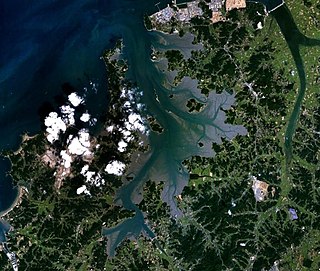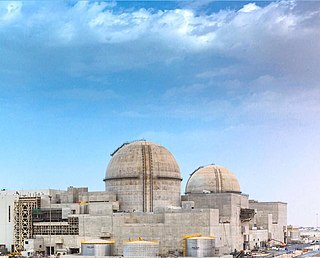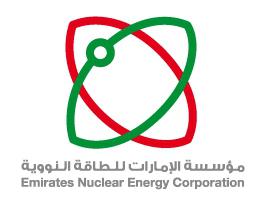| Company type | Public |
|---|---|
| Industry | Nuclear power |
| Founded | 1982 |
| Headquarters | , |
| Products | Nuclear fuel |
| Korean name | |
| Hangul | |
| Hanja | |
| Revised Romanization | Hanjeon Wonjaryeong Yeollyo |
| McCune–Reischauer | Hanjŏn Wŏnjaryŏng Yŏllyo |
| Website | www |
KEPCO Nuclear Fuel (KEPCO NF) is a South Korean public enterprise established in 1982. It provides nuclear fuels to 24 nuclear power plants in South Korea. The price of the nuclear fuel provided by the company accounts for 60% of the average international price. [1]

The Kansai Electric Power Company, Incorporated, also known as Kanden (関電), is an electric utility with its operational area of Kansai region, Japan.
Doosan Enerbility Co., Ltd., formerly known as Doosan Heavy Industries, is a heavy industrial company headquartered in Changwon, South Korea. It was established in 1962. Its business includes manufacturing and construction of nuclear power plants, thermal power stations, turbines and generators, desalination plants, castings, and forgings.
Korea Hydro & Nuclear Power is a subsidiary of the Korea Electric Power Corporation (KEPCO). It operates large nuclear and hydroelectric plants in South Korea, which are responsible for about 27 percent of the country's electric power.
The Korea Atomic Energy Research Institute (KAERI) in Daejeon, South Korea was established in 1959 as the sole professional research-oriented institute for nuclear power in South Korea, and has rapidly built a reputation for research and development in various fields.
Korea Electric Power Corporation, better known as KEPCO (Korean: 켑코) or Hanjeon (Korean: 한전), is the largest electric utility in South Korea, responsible for the generation, transmission and distribution of electricity and the development of electric power projects including those in nuclear power, wind power and coal. KEPCO, through its subsidiaries, is responsible for 93% of Korea's electricity generation as of 2011. The South Korean government owns a 51.11% share of KEPCO. Together with its affiliates and subsidiaries, KEPCO has an installed capacity of 65,383 MW. On the 2011 Fortune Global 500 ranking of the world's largest companies, KEPCO was ranked 271. KEPCO is a member of the World Energy Council, the World Nuclear Association and the World Association of Nuclear Operators. As of August 2011, KEPCO possesses an A+ credit rating with Fitch Ratings, while Moody's has assigned KEPCO an A1 stable rating.
Daedeok Innopolis, formerly known as Daedeok Science Town, is the research and development district in the Yuseong-gu district in Daejeon, South Korea. The plan to concentrate research institutes and universities was made in 1967 and president Park Chunghee approved subsequent master planning in 1973. Now the district contains over 20 major research institutes and over 40 corporate research centers. There are 232 research and educational institutions to be found in Daejeon, many in the Daedeok region, among them the Electronics and Telecommunications Research Institute and the Korea Aerospace Research Institute. A number of IT venture companies have sprung up in this region due to the high concentration of Ph.Ds in the applied sciences. Korea has invested heavily in building up the research expertise for over 30 years, creating long-term research programs. Over 7,000 PhD researchers are in the sciences in Daedeok and it had the most application for patents during 2000–2011 among the National Industrial Complex.
The anti-nuclear movement in the Philippines aimed to stop the construction of nuclear power facilities and terminate the presence of American military bases, which were believed to house nuclear weapons on Philippine soil. Anti-nuclear demonstrations were led by groups such as the Nuclear-Free Philippines Coalition (NFPC) and No Nukes Philippines. Coalitions argued that American bases in the Philippines perpetuated nuclear threats from other opponent nations of the United States, and that nuclear testing was transpiring in these bases. The nuclear threats and the bases also represented foreign intervention from the United States, which was a staunch issue among nationalists.

South Korea is a major energy importer, importing nearly all of its oil needs and ranking as the second-largest importer of liquefied natural gas in the world. Electricity generation in the country mainly comes from conventional thermal power, which accounts for more than two thirds of production, and from nuclear power.

Garorim Bay Tidal Power Station is a planned tidal power plant in Garorim Bay, on the west coast of South Korea. The project is developed by Korea Western Power Company Limited and was in the process of receiving government approval as of November 2008.
KEPCO Plant Service & Engineering Co., Ltd., a subsidiary of KEPCO, is a South Korean public enterprise established in 1974 to provide electronic power and industrial facilities.

The United Arab Emirates is installing nuclear-powered plants to meet their electricity demand, which is estimated to increase from 15 GWe to over 40 GWe in 2020. In December 2009, the US and UAE signed a Section 123 Agreement for peaceful nuclear cooperation. The UAE has also signed Nuclear Non-Proliferation Treaty (NPT), along with the additional protocol.
KEPCO E&C is a power plant design and engineering company in South Korea. It was established in 1975 as a public enterprise. KEPCO E&C engages in designing, engineering, and constructing nuclear and fossil power plants. The company operates as a subsidiary of Korea Electric Power Corporation (KEPCO).

Pakistan–South Korea relations refers to bilateral diplomatic relationship between Pakistan and South Korea. Since the 1980s, the relations between the two Asian states have improved and periodically enhanced. Pakistan has an embassy in Seoul, South Korea, and South Korea has an embassy in Islamabad, Pakistan. Pakistan is one of the few countries that has good relations with both North Korea and South Korea.
Vietnam is considering developing nuclear power for peaceful purposes based on modern, verified technology since 1995, and firm proposals surfaced in 2006. In November 2016 Vietnam suspended its nuclear power plans. In 2022 industry and trade minister Nguyen Hong Dien announced that developing nuclear power is an “inevitable trend” for Vietnam, and will help the country to become carbon neutral by 2050.
NuGeneration (NuGen) was a company that planned to build a new nuclear power station nearby the Sellafield nuclear site in the United Kingdom. The proposed site was called Moorside, and is to the north and west of Sellafield. On 8 November 2018, Toshiba announced their withdrawal from the project and intent to liquidate NuGen.

The Barakah nuclear power plant (BNPP) is the United Arab Emirates' first nuclear power station, the first nuclear power station in the Arabian Peninsula, the second in the Persian Gulf region and the first commercial nuclear power station in the Arab World. It consists of four APR-1400 nuclear reactors. Total nameplate capacity is 5600 MW which is intended to supply up to 25% of UAE's electricity needs. The site is in the Gharbiya region of Abu Dhabi, on the coastline between the Persian Gulf and the E11 highway, 50 km west of Ruwais.

The APR-1400 is an advanced pressurized water nuclear reactor designed by the Korea Electric Power Corporation (KEPCO). Originally known as the Korean Next Generation Reactor (KNGR), this Generation III reactor was developed from the earlier OPR-1000 design and also incorporates features from the US Combustion Engineering (C-E) System 80+ design. Currently in South Korea there are 3 units in operation, and 3 units in construction. Three units are completed and in commercial operation in the United Arab Emirates at Barakah, with one more under construction at the same plant.
Egbin Power Plc is the largest power generating station in Nigeria with an installed capacity of 1,320 MW consisting of 6 Units of 220MW each. The station is located at Ijede / Egbin, in Ikorodu, It is about 40 km north east of the city of Lagos, and is situated on low land in Ijede and bounded by the Lagoon to the south, Agura/Gberigbe to the north and situated in Ijede Local Council Development Area.
Moorside nuclear power station is proposed for a site near Sellafield, in Cumbria, England. The original plan by NuGeneration, a British subsidiary of Toshiba-owned Westinghouse Electric Company, had the station coming online from 2024 with 3.4 GW of new nuclear capacity, from three AP1000 reactors. Work up to 2018 would include acquiring the site licence, the development consent order, and other required permits and permissions to start work. Site preparation was to take two years, up to 2020.

The Emirates Nuclear Energy Corporation is the entity responsible for the deployment and ownership of nuclear energy plants in the United Arab Emirates (UAE).